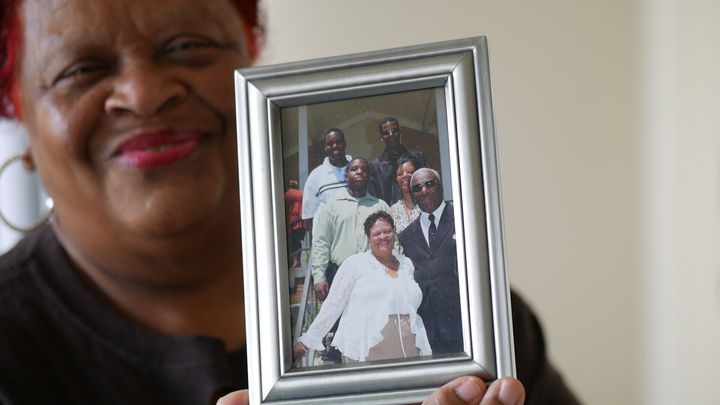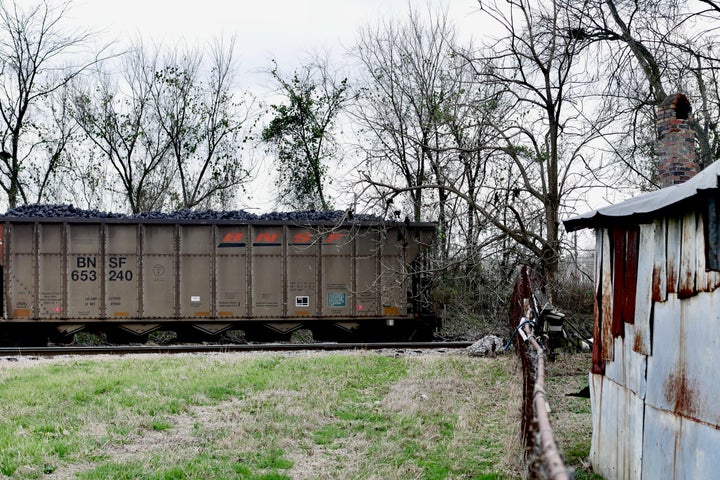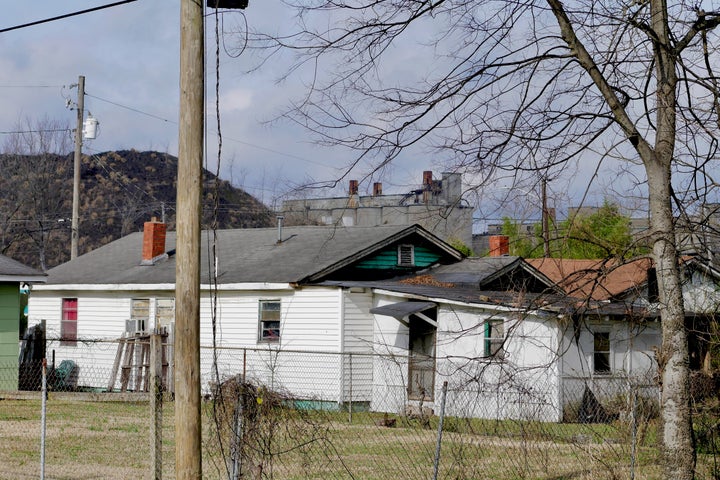
This is the second story in a three-part series on the environmental crisis in Birmingham, Alabama, co-published with Scalawag. Read part one here.
Delores Barkers and her husband, Phillip, moved to the Harriman Park neighborhood of Birmingham, Alabama, as newlyweds 48 years ago.
Now 71, Barkers loves remembering those early days: tending house with Phillip, raising kids who played outside until nightfall. Things were good, for the most part.
Her hair in rollers, coffee hot on the counter, Barkers welcomed me into her bungalow early one morning. The neatly kept home with its bright red door stands in stark contrast to what surrounds it — steel mills, a cement plant and two major producers of coke, a high-carbon fuel made by baking coal.
“If I knew what I know today, there’s no way I’d be in this area,” said Barkers, who worked as an administrator for public schools. “No way.”
Harriman Park is one of three neighborhoods in the 35th Avenue Superfund site, an area that the Environmental Protection Agency designated for cleanup after testing in 2009 revealed unsafe levels of arsenic, lead and polycyclic aromatic hydrocarbons like benzo(a)pyrene in the soil.
Ten years later, taxpayers have spent $25 million, and the cleanup is still underway. It’s been complicated by a plot to intentionally mislead residents about the EPA’s presence, a scandal that resulted in federal bribery convictions against an industry leader, his lawyer and one elected official as well as indictments and ethical charges against the then-administrator of the EPA’s Southeast region and the resignation of the local NAACP president. Their efforts remain successful, as some residents still have not approved the EPA to test soil on their property.

When Phillip died in 2015, he had just begun enjoying retirement after 34 years as a bus driver. They took up traveling. “And then he started getting puny, getting sick,” Barkers said.
He died at 73, and the official cause of death was listed as an undiagnosed age-related illness. Her husband didn’t smoke or drink, had slightly higher than average blood pressure, but was overall in good health, Barkers said. She could never prove a connection to the pollution in their neighborhood, but she suspected it. His breathing had gotten “worse and worse” over the years, she said.
Like Barkers, other residents in North Birmingham are holding out hope that they might be compensated — at least financially — for the decreased property values, the medical bills, and the trauma of illness and early deaths of loved ones that they believe are the result of living in a toxic environment. But they’re deeply skeptical that the industries will be regulated in a way that ensures their safety.
Living in a Superfund site means living with daily fear for your own safety. In North Birmingham, it also means living with the burden of reporting potential environmental infractions by powerful companies to the ineffective watchdogs at state regulatory agencies.

Barkers fills her sunroom with houseplants, hoping to filter out whatever toxins might blow through the front door. We spend part of the morning there, looking at the family photos that adorn the walls and bookshelves.
All four of Barkers’ children and two of her grandchildren have breathing difficulties, ranging from chronic allergies to debilitating asthma. Like many of her neighbors, she has spent her life managing the financial and emotional costs of her family’s illnesses.
She said she’s tried to come to peace with her husband’s passing, but struggles to do the same with the ongoing trauma in her neighborhood.
“It’s like we’re a throwaway community,” Barkers said.
Part of that frustration is rooted in the way industrial pollution is regulated. Alabama’s regulatory agencies, like many in the U.S., rely largely on self-reporting by companies, some of which have a bad track record for keeping emissions within legal limits.
Companies have staffers or a designated third party read on-site sensors, record emissions levels and then report to the correct government agency when there is an overage that indicates a problem, explained Jonathan Stanton, the director of environmental health at the Jefferson County Health Department, which is based in Birmingham.
The health department also has its own monitoring devices and employees to track levels of harmful emissions in the air. But the on-site sensors are the only way to distinguish which plant or factory is responsible for what pollutant.
The health department and the Alabama Department of Environmental Management ask residents to report any flooding, odd odors, smoke or other potential environmental issues. Stanton said the health department follows up on all reports, no matter the level of the potential problem.
But Stanton said that when residents call, they often don’t want to leave an official report, which means their complaint doesn’t get logged into the system. The department wishes more people would make it official, he said. (An official report can be made over the phone or in person, is anonymous, and takes about two minutes.)
North Birmingham residents say the fear of filing a report is likely a carryover from the days when company men threatened people who complained. Others wonder what the point of reporting is when the emissions are nonstop, and they don’t feel that calling the government has fixed the problems.
They aren’t even sure who is in charge when they want to call, given the multiple agencies involved. The county health department monitors air quality, the state Department of Environmental Management monitors the soil and water, and the EPA is responsible for the cleanup.
Gloria Moore, who lives around the corner from Barkers, said she no longer makes reports, even though her home is directly across the street from a coke plant.
“I’m too old, too tired for that,” she said.
Instead, she relies on activists like Keisha Brown to relay information. A lifelong North Birmingham resident, Brown has advocated for environmental changes here for nearly a decade. She said when she calls in to report issues, she’s often bounced between agencies.
“Why is everything on the residents?” Brown asked.
A recent settlement could give the community some financial help. In February 2019, Drummond Company, one of the major coke producers, was ordered to pay $775,000 to be split equally between the EPA and the county health department over benzene pollution. Stanton said the county money will go directly to the affected neighborhoods and will likely be used for a “supplemental environmental project” administered with the EPA.
After similar settlements in other parts of the country, these EPA-affiliated projects have proved difficult to manage and have not always directly benefited the local community. Many North Birmingham residents would prefer to put the money in a community trust that controls how the money is spent. They’re also organizing for reparations that would finally mean equal justice.

Charlie Powell is the founding director of the local group People Against Neighborhood Industrial Contamination, or PANIC. He doesn’t want better industry regulation, however. Powell wants residents relocated.
If North Birmingham is placed on the EPA’s National Priorities List of hazardous pollutant sites, there could be money to help people relocate. But the state government must support that designation, and thus far, the Alabama Environmental Management Commission has declined to do so.
The commission has been in disarray. A former chairman was indicted as part of the cleanup scandal. Some of its current members have been urged to resign over their connections to the scandal.
The commission denied a National Priorities List request for North Birmingham again in 2018. Critics of the decision feel like this was just another sign of the industries’ influence over state government.
Powell and his wife lived in North Birmingham for decades, before moving to another neighborhood in the city. Now his wife is fighting a terminal cancer diagnosis.
“We should have moved out of there a long, long time ago,” he said.
It’s not fair to expect residents, many of whom are sick or elderly, to monitor the site, Powell said. Nor should they have to choose whether to stay in a toxic neighborhood or walk away from homes they have zero chance of selling. Powell said he suspects officials are just waiting for current residents to die off so the area can be rezoned as an industrial space.
Back when Barkers and her husband were newlyweds, they paid $20,000 for their home, which would be about $173,000 in today’s market. It was recently appraised for $65,000, though there’s no way anyone would pay that much for a house in a Superfund site.
Barkers dreams of moving to a condo in a livelier neighborhood, someplace with a grocery store and little shops that feel safe and welcoming. But she’s still not ready to let go of her house for nothing.
“It’s like all your work that you’ve been doing for years and years and years and years — just, you know, just gone,” she said. “It really makes you feel terrible because that’s not the way it should have been.”
